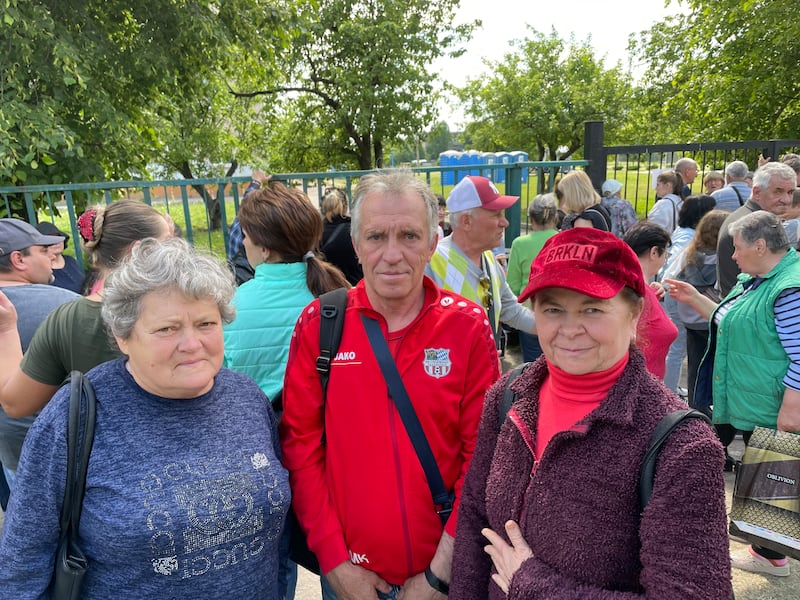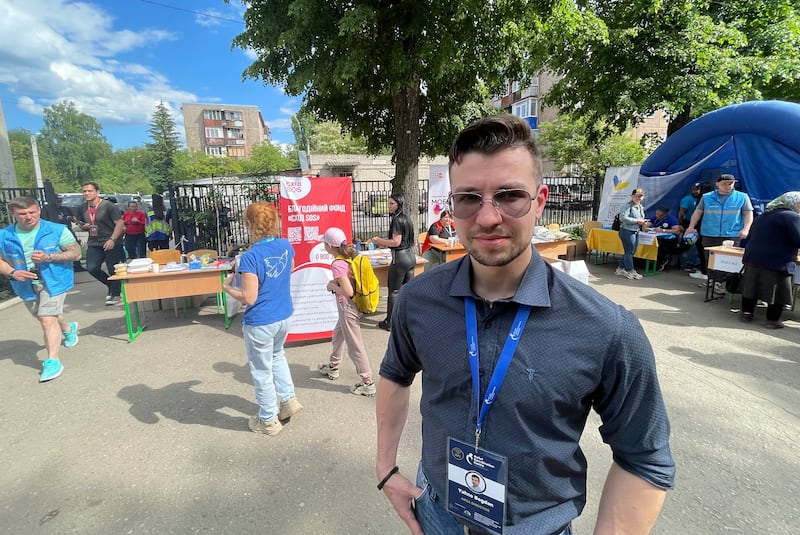Ukraine built the small settlement of Vilcha in its eastern Kharkiv region in the early 1990s, for residents of a village of the same name close to the Chernobyl atomic power plant that was evacuated after the world’s worst nuclear accident in 1986.
New Vilcha, as it was sometimes known, was founded near the town of Vovchansk and barely 15km from the Russian border – a location that has now brought more disaster to its people and forced them to flee their homes for a second time.
“I feel like I’ve been through two wars now. We had to leave our old Vilcha and now we’ve had to escape from the shelling,” says Olha, one of about 10,000 people who have fled intense Russian artillery, missile and bomb strikes on border towns and villages this month and sought the relative safety of Kharkiv city, 35km from the border.
“New Vilcha was so lovely. We have little houses there and always plant many flowers around the village to make it pretty. It was awful to leave but all the shelling made it impossible to stay,” adds Olha, who declined to give her surname.
She arrived in Kharkiv with a few belongings and her dog but had to leave behind rabbits and other animals she reared after her house was damaged in an artillery strike. She is luckier than most displaced people in having a flat in Kharkiv in which to stay.

“Of course we want to go back, but no one knows if it will be weeks or months before we can,” says her Vilcha neighbour Yuriy, as they wait at a reception centre with dozens of other evacuees to register for a one-time “displacement payment” of 10,800 hryvnia (€250).
“On February 24th 2022, we woke up and found the village had been occupied by the Russians. We’re so near the border that it took them very little time to reach us,” he adds, referring to the start of Russia’s full-scale invasion of Ukraine.
“We lived under occupation until September that year, when the Russians left and some local collaborators left with them,” Olha recalls. “We thought the worst was over, but now this has happened.”
Vilcha is still under Ukrainian control, but Russia seized about a dozen abandoned or sparsely populated border villages in a swift assault on the north of Kharkiv region that began on May 10th, and heavy fighting continues on the outskirts of Vovchansk and the village of Lyptsi.
“It was too dangerous to stay. We’ve spent most of our time recently in the basement hiding from shelling,” says Oksana from Losivka, another village outside Vovchansk.
“We had planted things for this year in our allotment, we had a dog and cats. We just had to set them free and go. Hopefully the soldiers will look after the dog,” she adds.
“We had everything we needed there, we grew plenty of food and had preserves in the cellar. I basically arrived in Kharkiv with the clothes that I’m standing up in, and three plates, three spoons and three cups.”
[ A Ukrainian writer on his journey from torture camp to front lineOpens in new window ]
[ Ukraine battles Russia for eastern border town as US rushes arms to front lineOpens in new window ]
She brought the utensils for the relatives she fled with, and her brother stayed in Losivka to look after the family house and land for as long as possible.
Mykola, from the village of Lukyantsi, about 10km from Lyptsi, was advised earlier this month by a friend in Ukraine’s state emergency service to get out while he still could.
“The Russians were firing and our side was firing at them. The only place you could be was down in the basement. It was terrible,” he says.
“The walls and windows would shake with the shelling. You just had no idea where the next thing would land... And drones were flying over the village and we had no idea if they were ours or theirs,” says his neighbour, Nadiya.
“We were occupied in 2022 and we know how quickly it can happen – literally overnight. We could see the buildings on the edge of Kharkiv but the Russians wouldn’t let us go there, and said we could only evacuate to Russia,” she recalls.
“It’s terrible to think of going back to that situation again. So we left and came to Kharkiv.”

Kyiv’s military says it has stopped Russia’s advance in the region and vows to regain lost territory but also warns that similar attacks may soon begin on border areas of neighbouring Sumy province, as Moscow’s forces try to stretch Ukraine’s outnumbered and outgunned defences to breaking point in the coming months.
Sudden influxes of evacuees add to the strain for cities such as Kharkiv, which has welcomed hundreds of thousands of Ukrainians displaced from occupied territory since Russia began its armed attacks on its neighbour a decade ago.
[ Kharkiv attack a sign of worse to come unless Ukraine and West move fastOpens in new window ]
“We prepared for something like this, with many meetings with local and regional authorities and NGOs that would take part in the [evacuation] process. We were sure [an escalation in Kharkiv region] would happen, but didn’t know when or exactly where, so we planned for different scenarios,” says Bogdan Yahno of the relief co-ordination centre that has been the arrival point in Kharkiv for thousands of evacuees this month.

The centre has also managed much of the logistics of the evacuation effort, gathering evacuation requests and matching them with NGOs that could take people to safety, often at great risk to themselves, using a combined fleet of about 65 vehicles.
When they arrive at the centre, which has taken over a school premises in Kharkiv, evacuees are offered essentials by a host of NGOs – food, water, clothes, medical and psychological help – and they can register for financial assistance.
Most arrivals stay with family or friends in Kharkiv and the surrounding area, and the rest are taken to flats, hostels, dormitories and other available accommodation.
Yahno reports a shortage of places for people with mobility problems or pets, but says Kharkiv is still just as welcoming as when he arrived from Donetsk following its capture by Russian-led militants in 2014.
“I think it’s a great place,” he says, remembering how welcome he felt in Kharkiv at a time when not everyone in Ukraine wanted to rent accommodation to displaced people.
“I found a flat here and called the owner, and when I said I’m from Donetsk he immediately gave me a 30 per cent discount,” Yahno recalls.
“And you can still see it now, it’s continuing,” he adds, as the volunteer-powered effort to look after the latest evacuees whirls around him.
“We’re still on the front line and we still understand that. The border is so close that if our military made just one huge mistake, they [the Russians] could be here in a few hours.”
Russian president Vladimir Putin says he wants to turn border areas of Kharkiv region into a buffer zone to protect neighbouring parts of his country from attack.
For their part, thousands of Ukrainians hope their embattled soldiers can find a way to thwart Putin’s plan and allow them to return home.
“I don’t know if we’ll be able to go back to Vilcha,” Olha says. “But there’s always hope.”
- Sign up for push alerts and have the best news, analysis and comment delivered directly to your phone
- Find The Irish Times on WhatsApp and stay up to date
- Our In The News podcast is now published daily – Find the latest episode here




















